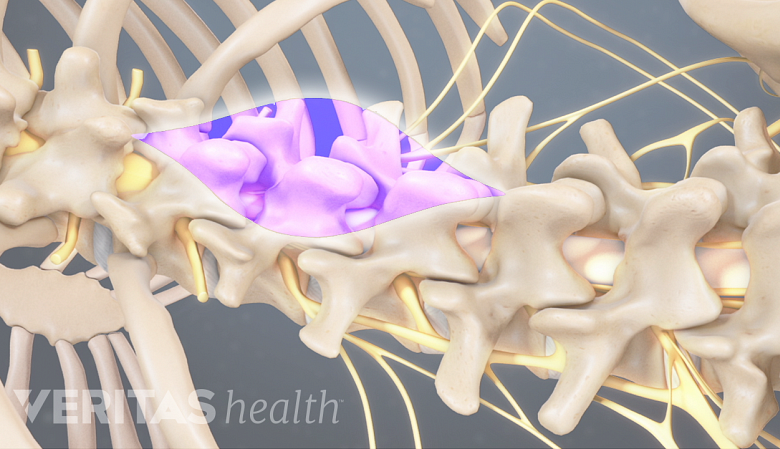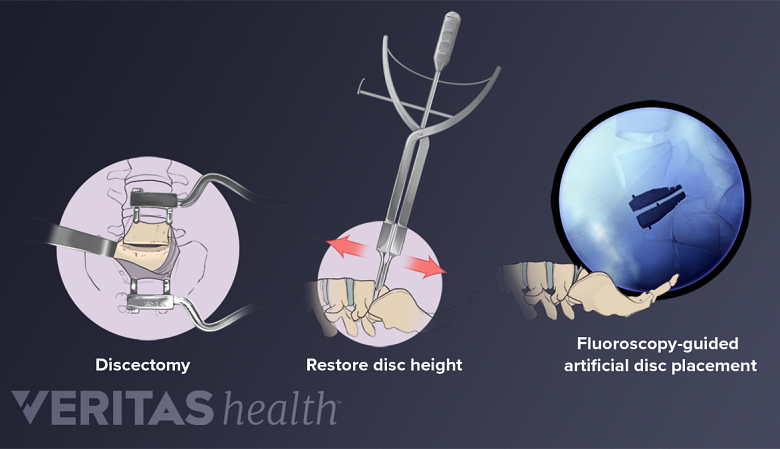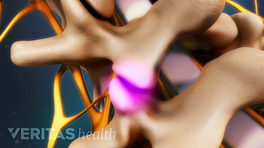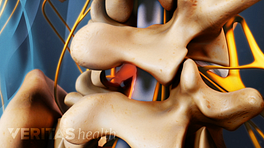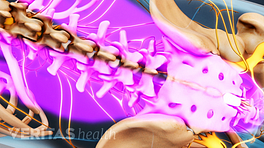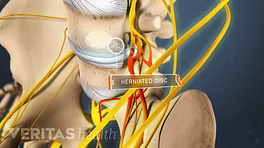The first type of spine surgery that became commonly performed as an outpatient procedure is the lumbar discectomy. This surgery is performed to removed the herniated portion of the lumbar disc. It has a high success rate, especially in relieving sciatica, caused by the herniated portion of the disc pressing against a nerve.
There are two common options in an outpatient lumbar discectomy—microdiscectomy and endoscopic (or percutaneous) discectomy:
In This Article:
- Outpatient Spine Surgery Considerations
- Lumbar Discectomy Outpatient Spine Surgery
- Outpatient Lumbar Laminectomy or Laminotomy
- Outpatient Posterior Cervical Foraminotomy and Discectomy
- Outpatient Anterior Cervical Discectomy and Fusion (ACDF)
- Outpatient Lumbar Fusion
- Pain Management After Outpatient Spine Surgery
Microdiscectomy
Microdiscectomy employs small incision and tissue-preserving techniques to minimize disruption to muscles.
Using modern microdiscectomy techniques, the surgeon is able to minimize the extent of the operation and potential for tissue damage by using a standard incision of 1 to 1.5 inches and focusing the tissue dissection on spreading the muscles and ligaments rather than cutting them.
Targeting techniques using fluoroscopic guidance minimize the incision necessary to gain a direct view of the surgical field. Magnification allows improved visualization of the nerve sac and the disc herniation. Bayoneted instruments allow precision manipulation of tissues without obstructing the direct view.
See How Microdiscectomy Surgery Is Performed
Due to minimal dissection of the muscles and other soft tissues, post-operative pain is tolerable. By removing the portion of the disc that is irritating the nerve, usually the pre-operative radiculopathy pain has diminished or resolved, and many patients feel immediate improvement in their leg pain when they wake up from the surgery.
See Pain Management After Microdiscectomy Surgery
Typically, patients will leave the recovery room, and go home, with less pain than they had before the surgery.
See Postoperative Care for Lumbar Microdiscectomy Surgery
For the carefully selected patient, outpatient lumbar microdiscectomy has become a routine surgical choice with highly predictable success rates. 1 Zahrawi F. Microlumbar discectomy. Is it safe as an outpatient procedure? Spine (Phila Pa 1976). 1994;19(9):1070-4. , 2 Pugely AJ, Martin CT, Gao Y, Mendoza-Lattes SA. Outpatient surgery reduces short-term complications in lumbar discectomy: an analysis of 4310 patients from the ACS-NSQIP database. Spine (Phila Pa 1976). 2013;38(3):264-71. , 3 Lang SS, Chen HI, Koch MJ, Kurash L, McGill-Armento KR, Palella JM, Stein SC, Malhotra NR. Development of an outpatient protocol for lumbar discectomy: our institutional experience. World Neurosurg. 2014;82(5):897-901.
Percutaneous and Endoscopic Discectomy
Discectomy is performed under the guidance of fluoroscopy to enable accurate precision.
These two minimally invasive approaches to discectomy are done through a thin tube, or series of tubes, which are inserted into the lower back to provide a corridor of sorts to allow the surgeon to access the offending disc herniation with minimal tissue disruption.
A guide wire is placed within the disc, or near the neuroforamen. Sequential cannulas (thin tubes) are placed over the central guide wire, gradually widening the tube, in order to push apart the surrounding soft tissues to provide an operative corridor.
See Spinal Anatomy and Back Pain
The spinal nerve exits through the space in the spinal column called the neuroforamen. Local anesthetics with some mild sedation are used. Because of the minimally invasive nature of the procedure, it is typically done on an outpatient basis.
See Spinal Cord and Spinal Nerve Roots
The incision for each tube is only a few millimeters long, and because they are small they are associated with minimal incisional pain. The challenge is secondary nerve irritation caused by the working channel and instruments during the procedure.
Once the instruments are removed, the pain is usually tolerable. If the bone spur or disc material causing the pain has been removed, there should be reduced pain from before surgery.
Both of the above procedures are commonly done on an outpatient basis; an overnight hospital stay would only be required if there are special considerations, such as the patient's medical condition or complicating factors, or if for some reason the patient would not be able to recover at home or in a place outside of a hospital.
- 1 Zahrawi F. Microlumbar discectomy. Is it safe as an outpatient procedure? Spine (Phila Pa 1976). 1994;19(9):1070-4.
- 2 Pugely AJ, Martin CT, Gao Y, Mendoza-Lattes SA. Outpatient surgery reduces short-term complications in lumbar discectomy: an analysis of 4310 patients from the ACS-NSQIP database. Spine (Phila Pa 1976). 2013;38(3):264-71.
- 3 Lang SS, Chen HI, Koch MJ, Kurash L, McGill-Armento KR, Palella JM, Stein SC, Malhotra NR. Development of an outpatient protocol for lumbar discectomy: our institutional experience. World Neurosurg. 2014;82(5):897-901.
